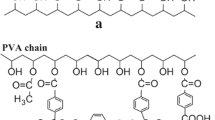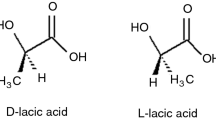Abstract
Synthesis of poly(epichlorohydrin-b-ethylene glycol) block copolymers was obtained via “click” chemistry of polyepichlorohydrin propargyl (PECH-propargyl) and polyethylene glycol azido (PEG-N3) with different molecular weights. For this purpose, polyethylene glycol bromine (PEG-Br) was obtained by reaction of PEGs with various molecular weights and 3-bromopropionyl chloride. PEG-N3 was synthesized by using PEG-Br with sodium azide (NaN3). PECH-propargyl was synthesized using polyepichlorohydrin and propargyl chloride. By reacting PECH-propargyl and PEG-N3, the block copolymers were obtained. The primary parameters, for example time, amount of solvent, and concentration, were evaluated. The products were characterized by FT-IR, 1H-NMR, GPC, TGA, SEM, and fractional precipitation techniques.







Similar content being viewed by others
References
Kolb HC, Finn MG, Sharpless KB (2001) Click chemistry: diverse chemical function from a few good reactions. Angew Chem Int Edit 40:2004–2021. https://doi.org/10.1002/1521-3773(20010601)40:11%3c2004:AID-ANIE2004%3e3.0.CO;2-5
Hein CD, Liu XM, Wang D (2008) Click chemistry, a powerful tool for pharmaceutical sciences. Pharm Res 25:2216–2230. https://doi.org/10.1007/s11095-008-9616-1
Moses JE, Moorhouse AD (2007) The growing applications of click chemistry. Chem Soc Rev 36:1249–1262. https://doi.org/10.1039/B613014N
Zhu DY, Cao GS, Qiu WL, Rong MZ, Zhang MQ (2015) Self-healing polyvinyl chloride (PVC) based on microencapsulated nucleophilic thiol-click chemistry. Polymer 69:1–9. https://doi.org/10.1016/j.polymer.2015.05.052
Binder WH, Sachsenhofer R (2007) ‘Click’ chemistry in polymer and materials science. Macromol Rapid Commun 28:15–54. https://doi.org/10.1002/marc.200600625
Xu J, Ye J, Liu SY (2007) Synthesis of well-defined cyclic poly(N-isopropylacrylamide) via click chemistry and its unique thermal phase transition behavior. Macromolecules 40:9103–9110. https://doi.org/10.1021/ma0717183
Bo Yan, Zhou H, Lai J, Wang Z, Luo C, Liu H, Jin X, Ma A, Chen W (2019) Pluronic F127 gels fabricated by thiol-ene click chemistry: preparation, gelation dynamics, swelling behaviors and mechanical properties. Polym Bull. https://doi.org/10.1007/s00289-019-02696-0
Tunca U (2013) Triple click reaction strategy for macromolecular diversity. Macromol Rapid Commun 34:38–46. https://doi.org/10.1002/marc.201200656
Altıntas A, Tunca U (2011) Synthesis of terpolymers by click reactions. Chem Asian J 6:2584–2591. https://doi.org/10.1002/asia.201100138
Parrish B, Breitenkamp RB, Emrick T (2005) PEG- and peptide-grafted aliphatic polyesters by click chemistry. J Am Chem Soc 127:7404–7410. https://doi.org/10.1021/ja050310n
Şanal T, Koçak İ, Hazer B (2017) Synthesis of comb-type amphiphilic graft copolymers derived from chlorinated poly(e-caprolactone) via click reaction. Polym Bull 74:977–995. https://doi.org/10.1007/s00289-016-1757-5
Xi W, Scott TF, Kloxin CJ, Bowman CN (2014) Click chemistry in materials science. Adv Funct Mater 24:2572–2590. https://doi.org/10.1002/adfm.201302847
Öztürk T, Meyvacı E (2017) Synthesis and characterization poly(ɛ-caprolactone-b-ethylene glycol-b-ɛ-caprolactone) ABA type block copolymers via “click” chemistry and ring-opening polymerization. J Macromol Sci Part A Pure Appl Chem 54:575–581. https://doi.org/10.1080/10601325.2017.1309251
Al-Kaabi K, van Reene AJ (2008) Controlled radical polymerization of poly(methyl methacrylate-g-epichlorohydrin) using N,N-dithiocarbamate-mediated iniferters. J Appl Polym Sci 108:2528–2534. https://doi.org/10.1002/app.27267
Cho BS, Noh ST (2013) Synthesis and thermal properties of ferrocene-modified poly(epichlorohydrin-co-2-(methoxymethyl)oxirane). Macromol Res 21:221–227. https://doi.org/10.1007/s13233-013-1074-x
Tang TT, Fan XS, Jin Y, Wang GW (2014) Synthesis and characterization of graft copolymers with poly(epichlorohydrin-co-ethylene oxide) as backbone by combination of ring-opening polymerization with living anionic polymerization. Polymer 55:3680–3687. https://doi.org/10.1016/j.polymer.2014.05.066
Lee KJ, Park JT, Koh JH, Min BR, Kim JH (2009) Graft polymerization of poly(epichlorohydrin-g-poly((oxyethylene) methacrylate)) using ATRP and its polymer electrolyte with KI. Ionics 15:163–167. https://doi.org/10.1007/s11581-008-0245-9
Öztürk T, Kayğın O, Göktaş M, Hazer B (2016) Synthesis and characterization of graft copolymers based on polyepichlorohydrin via reversible addition-fragmentation chain transfer polymerization. J Macromol Sci Part A Pure Appl Chem 53:362–367. https://doi.org/10.1080/10601325.2016.1166002
Göktaş M, Öztürk T, Atalar MN, Tekeş AT, Hazer B (2014) One-step synthesis of triblock copolymers via simultaneous reversible-addition fragmentation chain transfer (RAFT) and ring-opening polymerization using a novel difunctional macro-RAFT agent based on polyethylene glycol. J Macromol Sci Part A Pure Appl Chem 51:854–863. https://doi.org/10.1080/10601325.2014.953366
Öztürk T, Yavuz M, Göktaş M, Hazer B (2016) One-step synthesis of triarm block copolymers by simultaneous atom transfer radical and ring-opening polymerization. Polym Bull 73:1497–1513. https://doi.org/10.1007/s00289-015-1558-2
Öztürk T, Göktaş M, Savaş B, Işıklar M, Atalar MN, Hazer B (2014) Synthesis and characterization of poly(vinylchloride-graft-2-vinylpyridine) graft copolymers using a novel macroinitiator by reversible addition-fragmentation chain transfer polymerization. e-Polymers 14:27–34. https://doi.org/10.1515/epoly-2013-0011
Öztürk T, Göktaş M, Hazer B (2010) One-step synthesis of triarm block copolymers via simultaneous reversible-addition fragmentation chain transfer and ring-opening polymerization. J Appl Polym Sci 117:1638–1645. https://doi.org/10.1002/app.32031
Noshay A, Mcgrath JE (1977) Block copolymers: overview and critical survey. Academic Press, New York
Ruzette AV, Leibler L (2005) Block copolymers in tomorrow’s plastics. Nat Mater 4:19–31. https://doi.org/10.1038/nmat1295
Nguyen SH, Berek D, Capek I, Chiantore O (2000) Polystyrene-graft-poly(ethylene oxide) copolymers prepared by macromonomer technique in dispersion. I. Liquid chromatographic separation of product mixtures. J Polym Sci Part A Polym Chem b38:2284–2291. https://doi.org/10.1002/(SICI)1099-0518(20000615)38:12%3c2284:AID-POLA180%3e3.0.CO;2-E
Öztürk T, Kılıçlıoğlu A, Savaş B, Hazer B (2018) Synthesis and characterization poly(ɛ-caprolactone-co-ethylene glycol) heteroarm star-type amphiphilic copolymers by “click” chemistry and ring-opening polymerization. J Macromol Sci Part A Pure Appl Chem 55:588–594. https://doi.org/10.1080/10601325.2018.1481344
Çatıker E, Öztürk T, Atakay M, Salih B (2019) Synthesis and characterization of novel aba type poly(ester-ether) triblock copolymers. J Polym Res 26:123. https://doi.org/10.1007/s10965-019-1778-5
Şanal T, Oruç O, Öztürk T, Hazer B (2015) Synthesis of pH- and thermo-responsive poly(ɛ-caprolactone-b-4-vinyl benzyl-g-dimethyl amino ethyl methacrylate) brush type graft copolymers via RAFT polymerization. J Polym Res 22:1–12. https://doi.org/10.1080/10601325.2014.953366
Hasegawa N, Usuki A (2003) Arranged microdomain structure induced by clay silicate layers in block copolymer-clay nanocomposites. Polym Bull 51:77–83. https://doi.org/10.1007/~00289-003-0196-2
Johnson JA, Lu YY, Burts AO, Xia Y, Durrell AC, Tirrell DA, Grubbs RH (2010) Drug-loaded, bivalent-bottle-brush polymers by graft-through ROMP. Macromolecules 43:10326–10335. https://doi.org/10.1021/ma1021506
Johnson JA, Lu YY, Burts AO, Lim Y, Finn MG, Koberstein JT, Turro NJ, Tirrell DA, Grubbs RH (2011) Core-clickable peg-branch-azide bivalent-bottle-brush polymers by ROMP: grafting-through and clicking-to. J Am Chem Soc 133:559–566. https://doi.org/10.1021/ja108441d
Zhang M, Estournès C, Bietsch W, Müller AHE (2004) Superparamagnetic hybrid nanocylinders. Adv Funct Mater 14:871–882. https://doi.org/10.1002/adfm.200400064
Djalali R, Li SY, Schmidt M (2002) Amphipolar core–shell cylindrical brushes as templates for the formation of gold clusters and nanowires. Macromolecules 35:4282–4288. https://doi.org/10.1021/ma0113733
Zhang M, Drechsler M, Muller AHE (2004) Template-controlled synthesis of wire-like cadmium sulfide nanoparticle assemblies within core–shell cylindrical polymer brushes. Chem Mater 16:537–543. https://doi.org/10.1021/cm034760v
Li C, Gunari N, Fischer K, Janshoff A, Schmidt M (2004) New perspectives for the design of molecular actuators: thermally induced collapse of single macromolecules from cylindrical brushes to spheres. Angew Chem Int Ed 43:1101–1104. https://doi.org/10.1002/anie.200352845
Huang K, Rzayev J (2009) Well-defined organic nanotubes from multicomponent bottlebrush copolymers. J Am Chem Soc 131:6880–6885. https://doi.org/10.1021/ja901936g
Cheng C, Qi K, Khoshdel E, Wooley KL (2006) Tandem synthesis of core–shell brush copolymers and their transformation to peripherally cross-linked and hollowed nanostructures. J Am Chem Soc 128:6808–6809. https://doi.org/10.1021/ja061892r
Hadjichristidis N, Iatrou H, Pitsikalis M, Mays J (2006) Macromolecular architectures by living and controlled/living polymerizations. Prog Polym Sci 31:1068–1132. https://doi.org/10.1016/j.progpolymsci.2006.07.002
Deffieux A, Schappacher M (1999) Synthesis and characterization of star and comb polystyrenes using isometric poly(chloroethyl vinyl ether) oligomers as reactive backbone. Macromolecules 32:1797–1802. https://doi.org/10.1021/ma981612v
Velichkova RS, Christova DC (1995) Amphiphilic polymers from macromonomers and telechelics. Prog Polym Sci 20:819–887. https://doi.org/10.1016/0079-6700(95)00004-Y
Gacal B, Durmaz H, Tasdelen MA, Hizal G, Tunca U, Yagci Y, Demirel AL (2006) Anthracene-maleimide-based Diels–Alder “click chemistry” as a novel route to graft copolymers. Macromolecules 39:5330–5336. https://doi.org/10.1021/ma060690c
Pispas S, Hadjichristidis N (2003) Aggregation behavior of poly(butadiene-b-ethylene oxide) block copolymers in dilute aqueous solutions: effect of concentration, temperature, ionic strength, and type of surfactant. Langmuir 19:48–54. https://doi.org/10.1021/la020561z
Öztürk T, Hazer B (2010) Synthesis and characterization of a novel macromonomer initiator for reversible addition fragmentation chain transfer (RAFT). Evaluation of the polymerization kinetics and gelation behaviors. J Polym Sci Part A Polym Chem 47:265–272. https://doi.org/10.1080/10601320903527095
Öztürk T, Göktaş M, Hazer B (2011) Synthesis and characterization of poly(methyl methacrylate-block-ethylene glycol-block-methyl methacrylate) block copolymers by reversible addition-fragmentation chain transfer polymerization. J Macromol Sci Part A Pure Appl Chem 48:65–72. https://doi.org/10.1080/10601325.2011.528310
Asan N, Öztürk T (2017) Synthesis and characterization of poly(vinyl chloride-graft-ethylene glycol) graft copolymers by “click” chemistry. Hacet J Biol Chem 45:35–42. https://doi.org/10.15671/HJBC.2017.139
Silant’eva VG, Filatova NA, Mizerovskii LN (1996) Synthesis and study of block copolymers based on caprolactam and polyethylene glycol. Fibre Chem 28:278–281. https://doi.org/10.1007/BF01060147
Hazer B (2010) Amphiphilic poly(3-hydroxy alkanoate)s: potential candidates for medical applications. Int J Polym Sci 2010:423460. https://doi.org/10.1155/2010/423460
Erciyes AT, Erim M, Hazer B, Yağcı Y (1992) Synthesis of polyacrylamide flocculants with poly(ethylene glycol) segments by redox polymerization. Angew Macromol Chem 200:163–171. https://doi.org/10.1002/apmc.1992.052000113
Öztürk T, Cavicchi CA (2018) Synthesis and characterization of poly(epichlorohydrin-g-ε-caprolactone) graft copolymers by “click” chemistry. J Polym Mater 35:209–220. https://doi.org/10.32381/JPM.2018.35.02.6
Çatıker E, Meyvacı E, Atakay M, Salih B, Öztürk T (2019) Synthesis and characterization of amphiphilic triblock copolymers including β-alanine/α-methyl-β-alanine and ethylene glycol by “click” chemistry. Polym Bull 76:2113–2128. https://doi.org/10.1007/s00289-018-2561-1
Öztürk T, Meyvacı E, Bektaş H, Menteşe E (2019) Synthesis and characterization of ring-type and branched polymers including polyethylene glycols by “click” chemistry. SN Appl Sci 1:343. https://doi.org/10.1007/s42452-019-0360-4
Herzberger J, Niederer K, Pohlit H, Seiwert J, Worm M, Wurm FR, Frey H (2016) Polymerization of ethylene oxide, propylene oxide, and other alkylene oxides: synthesis, novel polymer architectures, and bioconjugation. Chem Rev 116:2170–2243. https://doi.org/10.1021/acs.chemrev.5b00441
Danner AK, Leibig D, Vogt LM, Frey H (2019) Monomer-activated copolymerization of ethylene oxide and epichlorohydrin: in situ kinetics evidences tapered block copolymer formation. Chin J Polym Sci 37:912–918. https://doi.org/10.1007/s10118-019-2296-y
Liu J, Gan Z (2014) Hydrophilic block azidation of PCL-b-PEO block copolymers from epichlorohydrin. Macromol Biosci 14:699–708. https://doi.org/10.1002/mabi.201300488
Öztürk T, Atalar MN, Göktaş M, Hazer B (2013) One-step synthesis of block-graft copolymers via simultaneous reversible-addition fragmentation chain transfer and ring-opening polymerization using a novel macroinitiator. J Polym Sci Part A Polym Chem 51:2651–2659. https://doi.org/10.1002/pola.26654
Hazer B, Erdem B, Lenz RW (1994) Styrene polymerization with some new macro or macromonomeric azo initiators having PEG units. J Polym Sci Part A Polym Chem 32:1739–1746. https://doi.org/10.1002/pola.1994.080320916
Macit H, Hazer B (2004) Synthesis of PMMA–PTHF–PMMA and PMMA–PTHF–PST linear and star block copolymers. J Appl Polym Sci 93:219–226. https://doi.org/10.1002/app.20455
Funding
The work was funded by Giresun University Scientific Research Fund (FEN-BAP-A-140316-48).
Author information
Authors and Affiliations
Corresponding author
Additional information
Publisher's Note
Springer Nature remains neutral with regard to jurisdictional claims in published maps and institutional affiliations.
Rights and permissions
About this article
Cite this article
Öztürk, T., Yörümez, C. Synthesis of block copolymer including polyepichlorohydrin and polyethylene glycol by “click” chemistry: evaluation of primary parameters of copolymerization. Polym. Bull. 77, 4773–4788 (2020). https://doi.org/10.1007/s00289-019-02989-4
Received:
Revised:
Accepted:
Published:
Issue Date:
DOI: https://doi.org/10.1007/s00289-019-02989-4




